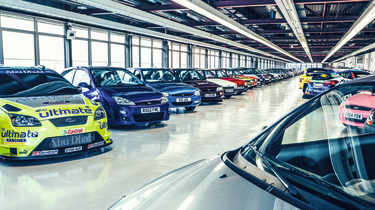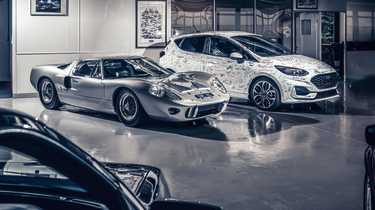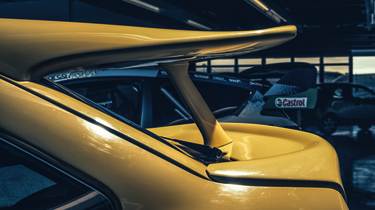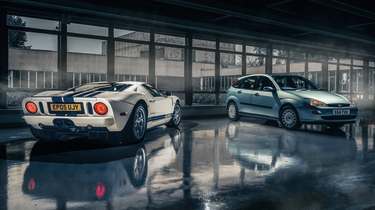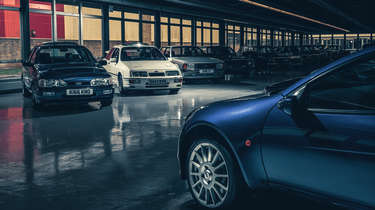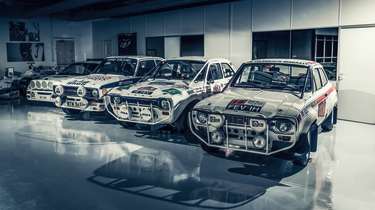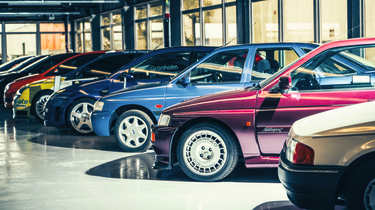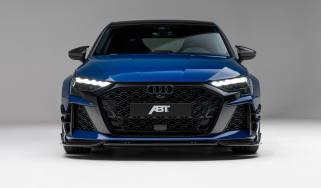Fast Ford heaven: a tour of the ultimate Ford garage
Who doesn’t love a fast Ford? Prepare for a nostalgia overload as we get a guided tour of Ford UK’s magnificent, newly rehomed Heritage Collection
Ford has always had an uncanny knack for giving the people what they want. Strolling through this greatest hits collection, past Cortina 1600Es and Fiesta XR2s, Sapphire Cosworths and Focus RSs, you’re reminded just how deeply embedded in our collective psyche the Blue Oval has become.
Len Keen sees it every time he conducts a tour: ‘More than any other manufacturer, people can associate with the cars here. You see it in their faces when they come in: what Fords mean to people.’ And that’s no happy accident. For successive generations, canny marketing underpinned by rigorous product development has engendered not only sales success but a deep and enduring affection.
> Ford Focus RS Mk1 (2002 - 2003): a rally-inspired hot hatch icon
Len’s ‘day job’ is press officer for vehicle operations at Ford’s Dunton HQ but he also has responsibility for the Heritage Collection, recently relocated from Dagenham to Daventry, and it’s a role he clearly loves – hardly surprising with access to so many iconic vehicles.
Vehicles like the stunning silver GT40 Mk3, ironically one of the very few models that Ford had trouble shifting back in the day. The Mk3 was the road version of the Le Mans-winning racer, the rear body extended to create luggage space, the 4.7-litre V8 detuned to 306bhp, the damping softened and the gearshift moved from the sill to the centre.
The original plan had been to build 30, possibly more if things had gone well. In fact the car here is one of only seven Mk3s built. ‘This one was pulled off the line and used as a press car and promotional tool,’ says Len. ‘It was also our chairman’s car at the time.’ Well, if you have the pick of any car in the range…
Why didn’t it sell? Partly on account of its high list price – £7500 in 1967 (£114,000 in today’s money) – partly because enthusiasts preferred the purity of the Mk1, a number of which were converted for road use. There was also a certain mid-engined rival by the name of Miura. But still, what a fabulous thing, and by some margin the most valuable car in the collection. ‘It’s insured for something over £5million,’ says Len, who’s one of the lucky few to give it regular exercise.
‘It’s marginal as a road car,’ he says. ‘It’s difficult to see out of, and with no air con it can get pretty uncomfortable.’ These days, though, it rarely ventures onto the road, more typically appearing at events like last year’s Goodwood Revival, where Len and a colleague gave VIP passenger rides between races.
‘It was a chance to experience what is an iconic vehicle for a lot of people,’ he says. And a pretty big thrill for Len too? ‘I’m always very much aware how privileged I am to drive not only this but a lot of the cars in the collection. But to drive the GT40 at Goodwood… very special.’
A lot of the vehicles here will be familiar to readers of car magazines over the years, as the majority started their lives as press demonstrators. And now that many of them have attained classic status, they’re in demand from various media all over again. ‘But we always make sure that people understand these are special examples,’ says Len. ‘Some of them are literally irreplaceable. That RS500 Mk2 Focus, for example, is prototype number 1.’
The space we’re in was for many years a vast, open-plan office: carpet tiles, desks and computer terminals as far as the eye could see. It was the nerve centre of both Ford’s customer services division and the parts operation that still runs out of the enormous adjacent warehouse – until recently the largest single-storey building in Europe. When more and more of the process moved online, the desks were no longer required and the space eventually became a dumping ground looking for a new purpose.
Meanwhile, the Heritage Collection had for years been housed in Dagenham in what Len refers to not so affectionately as ‘the old shed’. Cold and damp in winter, baking hot in summer, and with parts of the roof falling in, it wasn’t great for either the cars or their custodians.
‘Management looked at a number of potential new locations and then this came up as a possibility,’ Len recalls. ‘I’d visited before and I thought it might work, so I came up, had a look around and it went from there.’ The transfer of vehicles started in spring 2023, and there’s currently 90-odd on site, many of which haven’t been run for years. Technician Chris is now slowly working his way through them.
‘Generally the collection was very much hidden away,’ continues Len. ‘The focus now is to open it up, first and foremost to Ford employees. I’ve worked for the company for 29 years but there are lots of people who have worked for Ford longer than I have and have never seen the collection. Then it would be nice to get youngsters in from schools and colleges, and groups from the dealerships and car clubs too.
‘What the collection shows is how innovative we’ve been over the years. We may not have been the first, but we were often the first to bring it to the general public. For employees, it’s a reminder of all the times we’ve got it right. There are so many cars here that have become icons.’
Speaking of which, the RS200 over here is the last road-going example built. ‘Years ago there was a famous shot of an RS200 in police livery stopping a Sierra RS500,’ Len reminds me. ‘A few months ago we were contacted by Essex Police, who wanted to recreate the shot, so they put a livery on this car. Hornby have since done a Scalextric model of it.’ Accolades come no greater than that.
An orange Mk2 Focus ST is the very car that was used to develop the Mountune engine upgrades back in the noughties. Alongside is the first Mk1 Focus RS, wearing RS02 FMC. ‘I’m never sure if the plates aren’t worth more than the cars in some cases,’ laughs Len. Next in line is the last Escort ever built. ‘Job number 6,278,492, in July 2000,’ Len tells me, and not a crib sheet in sight.
The Escort Cossie alongside is one of the late Monte Carlo Editions. Directly opposite is a Fiesta WRC promo car – an exact replica of the rally cars in every respect apart from the small detail of never having been fitted with an engine. ‘I’d really like to get an engine into it at some point,’ muses Len.
Well, there’s one over here, though it might be a squeeze. Proudly displayed in the original cradle that would have eased its assembly is a 27-litre supercharged Rolls-Royce Merlin V12 engine from the Second World War era. But what’s it doing here? Well, when Britain faced its darkest hours and needed military engines in large numbers, who would it turn to but the masters of mass production? Many hundreds of Merlins were built at Ford’s Trafford Park facility in Manchester. Capable of producing well in excess of 1000bhp, they went into Spitfires, Lancaster bombers and Chieftain tanks. This was the last one built, and sure enough, it wears a tiny Ford badge.
A gorgeous Mk1 Escort Mexico catches my eye. ‘Custom pack interior,’ says Len. ‘Lovely car, has featured in a lot of magazine articles. The vinyl roof makes this one quite unusual.’ Further along, the motorsport section includes ‘the holy grail’ of Escorts, the actual 1970 London to Mexico winning car, FEV 1H, driven by Hannu Mikkola and Gunnar Palm for 16,000 miles across Europe, South and Central America. Alongside is a replica built for the 25th anniversary re-running of the event – which Mikkola and Palm also won.
F1 isn’t forgotten. The Stewart-Ford on display is believed to be the car that won the 1999 European GP with Johnny Herbert. A space has been left for another F1 car, a Benetton, that’s arriving soon. ‘With our re-entry as an engine supplier, it’s good to keep these vehicles in the public eye,’ says Len. There’s even a Galaxy that served as Eddie Jordan’s mobile office when he was running the Jordan F1 team.
But it can’t hold a candle to SuperVan 3. Built around a Ford C100 Group C car, this 7/8ths scale Transit originally had a Cosworth DFL engine, later replaced by a Formula 3000 unit. ‘Probably the loudest vehicle in the collection,’ laughs Len. Sadly the original SuperVan, after its 1970s promotional activities had finished, was broken up and its underpinnings – including its GT40 chassis – sold off.
These are the crowd-pleasers, but the ‘ordinary’ stuff is arguably even more evocative. There’s a very original-looking Mk1 Escort in period metallic green, the badge on the bootlid revealing it be a 1300 XL, and suddenly in my mind I’m transported back to a time when the distinctions between L, XL and GXL really seemed to matter. Ford, of course, being the original master of this sort of thing.
Then there’s the cooking-spec Mk1 Focus. ‘Probably one of the biggest game-changers Ford has ever had,’ says Len. ‘If you went from an Escort to this, it was a revelation. It showed that when we’re let loose with the right development engineers we can really move the game on. It took the opposition years to catch up.’
A very early Mk1 Fiesta looks absolutely tiny, while a brace of XR2s triggers yet more memories. There’s also the ten-millionth Fiesta, and the very last one built, signed by everyone on the line. ‘The Fiesta had been a great car for us,’ says Len, ‘but things come to a natural end. Carry on making it and you end up being Nokia rather than iPhone.’
There’s also the last Capri ever built, and an intriguing Capri prototype, a 3-litre auto with a Broadspeed-tuned V6 and Ferguson four-wheel drive. Six were built as development vehicles and later given to the F1 teams of the day, this one run by Brabham. ‘It was a toe in the water,’ says Len. ‘Could it be done; would it fit in the package? As it turned out, the system was a bit agricultural, the performance loss from four-wheel drive too great and it would have cost too much to be viable.’
A Mondeo ST24 rubs shoulders with an entry-level version. ‘Another game-changer,’ says Len, and another reminder of how deeply some of these vehicles are embedded in the national psyche. I mean, who could forget Mondeo Man? Elsewhere there’s a Mk1 Transit, a vehicle that gave its name to a whole genre of commercial vehicle.
Seventies Granadas and Capris have me humming the theme tunes to The Sweeney and The Professionals. ‘BL had been supplying the cars but they were charging for them,’ reveals Len. ‘Ford went in and offered to provide them for free. The only condition was that our vehicles could never be driven by the bad guys!’ Hence all those crims in S-type Jags…
Nearby are a Racing Puma from the launch in San Francisco, and the last Sierra Sapphire Cosworth built. I can’t resist slipping inside the Sapphire, the textures and smells transporting me back to Performance Car tests of the early ’90s. ‘We always invite people to sit inside,’ says Len. ‘Because Ford has always been about accessibility. When you sit inside and get the smell and feel of a vehicle, that’s what evokes all the memories.’
Most evocative of all for me are the Cortinas, an ever-present fixture in my childhood and beyond. The collection includes the very last Cortina off the line – a Mk5 Crusader, no less. ‘If you were a company car driver in the late ’70s, early ’80s, this is what you wanted,’ says Len. ‘Great velour interior, wood cappings on the doors. You’d really made it as a sales rep if you got a Crusader.’
Moving even further back in time, a little further along there’s a Mk3 – a seriously cool car in the early ’70s with its Coke-bottle styling and quad headlamps – with (wait for it) a pulsating 1300cc engine. The same Kent engine went into everything from Fiestas to Capris. ‘It looks absolutely lost in the engine bay,’ laughs Len.
Rather more evocentric, there’s a Mk2 1600E with its handsome Rostyle wheels and impressive array of auxiliary dials on the wooden dash. ‘It was a Cortina GT with the Executive interior,’ Len recalls. ‘Everyone aspired to a 1600E.’
Coolest of all, and Len’s personal favourite of the whole collection, is the Mk1 Lotus Cortina. Again it’s an original launch vehicle, which Ford wisely hung onto. ‘We took this with the GT40 to the Revival and it was a very big hit,’ says Len.
‘As I tell everyone, when I retire this is the one I’m going to steal,’ he chuckles. ‘My getaway car…’
To inquire about an organised group tour of the collection, email Len Keen at lkeen@ford.com
This story was first featured in evo issue 320.
